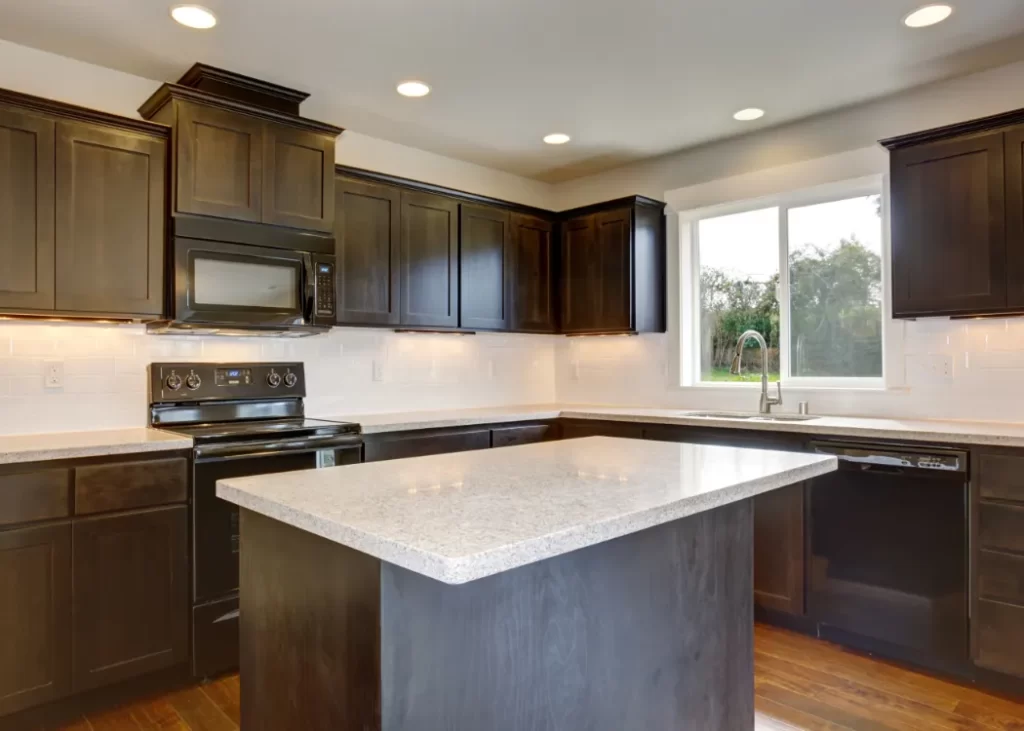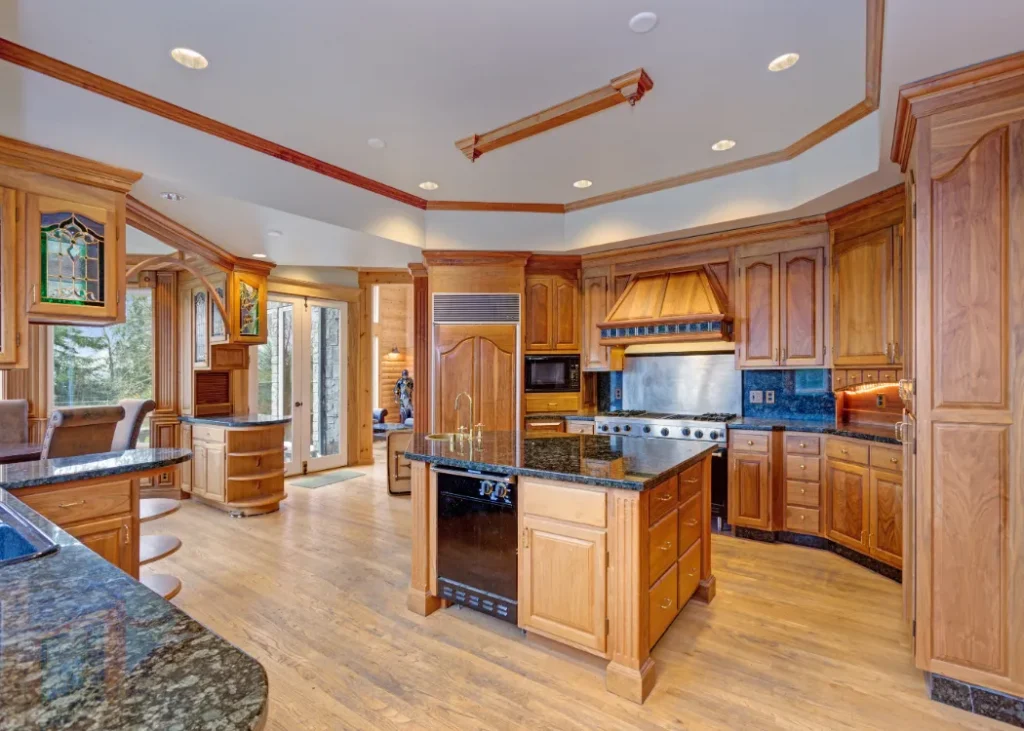
Cost: $200+
Time: 4+ days
Skill: Intermediate
Are your kitchen cabinets looking worn out, dated, or generally in need of an upgrade? Do you want to do this without spending an arm and a leg?
In this article, you can learn how to refinish kitchen cabinets, giving your kitchen a newer look without a whole remodel (although kitchen remodeling is a good option if you need more than just cabinets refinished). Refinishing cabinets is a great way to give them an updated look without the expense and hassle of installing new cabinets.
Doing it yourself is also a cost-effective alternative if you have some basic handyman skills at your disposal. Read on for our step-by-step guide on how to refinish kitchen cabinets. By the end, you’ll feel more confident in your kitchen cabinet refinishing skills.
Tools
- Gloves
- Respirator
- Paintbrush
- Sandpaper
- Sanding block
- Orbital sander
- Putty knife
- Scraper
- Rags
- Drop cloth
- Tack cloth
- Steel wool
Materials
- Stain
- Varnish
- Paint stripper
- Wood sealer
- Wood filler
- Denatured alcohol
- Painter’s tape
- Chlorine bleach*
*If needed
How To Refinish Kitchen Cabinets

Safety Considerations & Prep Work Area
Before beginning any project around the house, it’s important to ensure that you have all of the necessary safety equipment and supplies on hand. When it comes to refinishing kitchen cabinets, proper ventilation is key. Make sure that windows and doors are open to allow for adequate airflow, or use a respirator if needed. Lay down drop cloths and remove or put up anything that could get in the way.
1. Label Kitchen Cabinet Doors And Openings
Once all safety precautions are taken care of, and your work area is prepped, it’s time to start prepping the cabinets themselves. Start by labeling each cabinet door and drawer with corresponding letters on painter’s tape so they don’t get mixed up during the refinishing process. This will help keep everything organized and make reassembling them easier.
2. Remove Cabinet Doors And Cabinet Hardware

Take off all the knobs, handles, and hinges from each door and put them in labeled bags, so they’ll be easy to find when it comes time to reattach them. Don’t forget the screws! Once everything has been taken off, you can safely remove the doors from the cabinet frames.
3. Clean And Degrease
Now that all of the hardware has been removed from the cabinet doors and frames, it’s time for a good cleaning. If necessary, use a degreaser or other cleaning agent to remove any grease buildup or dirt from the surfaces of your kitchen cabinets. This will help ensure that your paint job looks its best once complete. Be sure to thoroughly rinse off any cleaning solutions before moving on to the next step.
4. Remove The Old Finish
It’s time to remove any existing finish from both cabinet doors and frames with either chemical strippers or sandpaper. Chemical strippers tend to work best for thick layers of paint or varnish but will require extra safety precautions due to their volatile nature.
Sanding may take longer than using chemical strippers but is often easier when dealing with thinner layers of paint or varnish that are harder to penetrate with chemicals. It also poses no additional safety concerns since sandpaper does not produce any hazardous fumes as chemical strippers do.
5. Fill Any Holes With Wood Filler
Cabinet doors may contain holes that need filling in before finishing can begin. To do this, purchase wood filler that closely matches the color of your cabinet doors at your local home improvement store. Fill in any deep scratches or dents. Make sure to allow ample time for drying before proceeding onwards with this project, or your cabinets may look weird.
6. Sand Cabinet Door Surfaces

Using an orbital sander with medium-grit sandpaper, lightly sand all cabinet door surfaces in order to create a smooth finish. Be sure to use even strokes in one direction while sanding so that you don’t leave visible marks on the wood.
7. Vacuum And Tack Cabinet Surfaces
Once you have finished sanding, vacuum up any dust particles and then tack cloth the entire surface area in order to remove any remaining debris before applying sealer. You can use a microfiber cloth and water; just be sure to wring out as much of the water as possible. Any leftover water can leave spots that will ruin the look of your cabinets, which means starting over.
8. Apply Sealer
Sealers are used to protect the wood from stains or discoloration over time due to exposure to water or sunlight. Before applying sealant, be sure that the surface is completely dry and free of dust particles. They’ll get between the wood and the sealant, causing it to crack or peel more quickly.
When ready, apply sealer using either a foam brush or roller, depending on your preference, making sure not to leave behind any streaks or uneven patches while doing so. Allow the sealer to dry completely before proceeding with staining (usually overnight).
9. Apply The Stain
Depending on the type of wood used for the cabinets, there are several different types of stains that can be used. It’s important to choose one that will bring out the natural beauty of the wood while still providing adequate protection against damage from water, heat, and sunlight.
Once you’ve selected your stain, use a paintbrush or rag to apply it evenly across all surfaces of the cabinet doors and drawers. Make sure not to saturate any one area too heavily with the stain, as this could cause discoloration or warping down the line.
10. Apply Protective Varnish
Once you’re done staining your cabinets, it’s time to seal them with a protective varnish. This will help preserve their beauty and ensure they last for years to come.
Start by wiping down all surfaces with a damp cloth before applying thin coats of protective varnish with either a brush or roller until all surfaces are covered entirely. Allow each coat of varnish plenty of time to dry before applying subsequent coats until you reach your desired level of protection.
11. Reinstall Cabinet Doors And Hardware
Finally, once your stain and varnish have dried completely, it’s time to reinstall the cabinet doors and hardware (hinges, knobs, etc.) Be sure not to overtighten screws as this can cause warping or cracks in the door panels over time. Just snug them up enough so that they won’t come loose but aren’t overly tight, either. Remove the painter’s tape labels as well.
12. Post-Job Walkthrough
Now you’ll want to walk through and examine your kitchen cabinets for any places that need touching up. This could include streaks, droplets, and other aesthetic errors. You’ll need to fix these before you can consider your project done.
Once everything looks to your liking, take a step back and admire your handiwork. You just refinished your own kitchen cabinets like a pro!
Kitchen Cabinet Refinishing vs Refacing vs Resurfacing

Refinishing
Refinishing is probably the most cost-effective of the three options. It involves stripping off any existing finishes and applying a new coat of paint or stain. The end result is that your cabinets will look like new again, but you will need to factor in the cost of supplies such as sandpaper, primer, paint or stain, and varnish into your budget. Plus, depending on how many coats of paint or stain you plan to apply, it could take several days before they are ready for use again.
Refacing
Refacing is a more involved process than refinishing but still doesn’t have the same cost as new kitchen cabinets. With refacing, you’ll keep the existing cabinet boxes but replace the doors and drawer fronts with custom-made ones in whatever style and finish you desire. You can also add new hardware such as knobs and handles at this stage if desired. This option usually takes about two weeks from start to finish and requires professional help for the best results.
Resurfacing
Resurfacing involves removing the doors from your cabinets and applying a thin veneer on top of them in order to give them a fresh look without having to completely strip them down first. While it’s not as costly as either refinishing or refacing (and doesn’t require professional help), resurfacing may not be ideal if there’s significant damage or wear and tear. Any imperfections will still be visible underneath the veneer when it’s applied.
Refinishing Kitchen Cabinets With Brucksch & Sons Contracting
Working with Brucksch & Sons Contracting and our team of experienced professionals is a great way to refinish cabinets. We strive to provide superior service that you can rely on for years to come. Whether you want a little touch-up or an entire overhaul of your kitchen, we’ve got you covered. Plus, we make sure to use quality materials from top brands.
If you’re ready to work with Brucksch & Sons Contracting on giving your kitchen cabinets the refresh they need, fill out our contact form today! Let’s make your kitchen look beautiful by giving those cabinets a sleek new finish. Don’t wait any longer – take action now and see the amazing results that come along with it.
